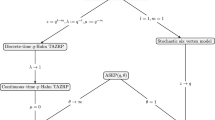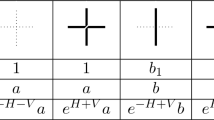Abstract
A recent paper (Kuniba in Nucl Phys B 913:248–277, 2016) introduced the stochastic \({\mathcal{U}_q(A_n^{(1)})}\) vertex model. The stochastic S-matrix is related to the R-matrix of the quantum group \({\mathcal{U}_q(A_n^{(1)})}\) by a gauge transformation. We will show that a certain function \({D^+_{\vec{m}}}\) intertwines with the transfer matrix and its space reversal. When interpreting the transfer matrix as the transition matrix of a discrete-time totally asymmetric particle system on the one-dimensional lattice \({\mathbb{Z}}\), the function \({D^+_{\vec{m}}}\) becomes a Markov duality function \({D_{\vec{m}}}\) which only depends on q and the vertical spin parameters \({\{\mu_x\}}\). By considering degenerations in the spectral parameter, the duality results also hold on a finite lattice with closed boundary conditions, and for a continuous-time degeneration. This duality function had previously appeared in a multi-species ASEP(q, j) process (Kuan in A multi-species ASEP(q, j) and q-TAZRP with stochastic duality, 2017). The proof here uses that the R-matrix intertwines with the co-product, but does not explicitly use the Yang–Baxter equation. It will also be shown that the stochastic \({\mathcal{U}_q(A_n^{(1)})}\) is a multi-species version of a stochastic vertex model studied in Borodin and Petrov (Higher spin six vertex model and symmetric rational functions, 2016) and Corwin and Petrov (Commun Math Phys 343:651–700, 2016). This will be done by generalizing the fusion process of Corwin and Petrov (2016) and showing that it matches the fusion of Kulish and yu (Lett Math Phys 5:393–403, 1981) up to the gauge transformation. We also show, by direct computation, that the multi-species q-Hahn Boson process (which arises at a special value of the spectral parameter) also satisfies duality with respect to \({D_{\infty}}\), generalizing the single-species result of Corwin (Int Math Res Not 2015:5577–5603, 2015).
Similar content being viewed by others
References
Alcaraz F.C., Rittenberg V.: Reaction–diffusion processes as physical realizations of Hecke algebras. Phys. Lett. B 314(3), 377–380 (1993)
Andrews, G.E., Askey, R., Roy, R.: Special Functions. vol. 71. Cambridge University Press, Cambridge (2001)
Barraquand G.: A short proof of a symmetry identity for the q–Hahn distribution. Electron. Commun. Probab. 19(50), 1–3 (2014) https://doi.org/10.1214/ECP.v19-3674
Barraquand G., orwin I.: The q-Hahn asymmetric exclusion process. Ann. Appl. Probab. 26(4), 2304–2356 (2016)
Belitsky V., Schütz G.M.: Self-duality for the two-component asymmetric simple exclusion process. J. Math. Phys. 56, 083302 (2015) https://doi.org/10.1063/1.4929663
Belitsky V., Schütz G.M.: Quantum algebra symmetry and reversible measures for the ASEP with second-class particles. J. Stat. Phys. 161(4), 821–842 (2015) https://doi.org/10.1007/s10955-015-1363-1
Belitsky, V., Schütz, G.M.: Self-duality and shock dynamics in the n-component priority ASEP. (2016). arXiv:1606.04587v1
Borodin, A., Corwin, I.: Discrete time q–TASEPs. Int. Math. Res. Not. (2013). https://dx.doi.org/10.1093/imrn/rnt206
Borodin A., Corwin I., Gorin V.: Stochastic six-vertex model. Duke Math. J. 165(3), 563–624 (2016) https://doi.org/10.1215/00127094-3166843
Borodin A., Corwin I., Sasamoto T.: From duality to determinants for q–TASEP and ASEP. Ann. Probab. 42(6), 2314–2382 (2014) https://doi.org/10.1214/13-AOP868
Borodin A., Corwin I., Petrov L., Sasamoto T.: Spectral theory for the q-Boson particle system. Compos. Math. 151, 1–67 (2015)
Borodin A., Petrov L.: Higher spin six vertex model and symmetric rational functions. Sel. Math. Newser. 1, 1–24 (2016)
Borodin, A., Petrov, L.: Lectures on Integrable probability: stochastic vertex models and symmetric functions. (2016). arXiv:1605.01349v1
Bosnjak G., Mangazeev V.: Construction of R-matrices for symmetric tensor representations related to \({U_q(\widehat{sl_n})}\). J. Phys. A Math. Theor. 49, 495204 (2016) https://doi.org/10.1088/1751-8113/49/49/495204
Cantini, L.: Asymmetric Simple Exclusion Process with open boundaries and Koornwinder polynomials. J. Phys. A Math. Gen. 37(18) (2004). arXiv:1506.00284v1
Cantini, L., Garbali, A., Gier, J.D., Wheeler, M.: Koornwinder polynomials and the stationary multi-species asymmetric exclusion process with open boundaries. J. Phys. A Math. Theor. 49, 444002 (2016). https://doi.org/10.1088/1751-8113/49/44/444002
Cantini, L., de Gier, J., Wheeler, M.: Matrix product and sum rule for Macdonald polynomials. (2016). arXiv:1602.04392v1
Carinci, G., Giardinà, C., Redig, F., Sasamoto, T.: A generalized asymmetric exclusion process with \({\mathcal{U}_q(\mathfrak{sl}_2)}\) stochastic duality. Probab. Theory Relat. Fields. (2015). https://doi.org/10.1007/s0040-015-0674-0
Carinci G., Giardinà C., Redig F., Sasamoto T.: Asymmetric stochastic transport models with \({\mathcal{U}_q(\mathfrak{su}(1,1))}\) symmetry. J. Stat. Phys. 163(2), 239–279 (2016) https://doi.org/10.1007/s10955-016-1473-4
Corteel S., Mandelshtam O., Williams L.: Combinatorics of the two-species ASEP and Koornwinder moments. Adv. Math. 321, 160–204 (2017) arXiv:1510.05023
Corwin I.: The q-Hahn Boson Process and q-Hahn TASEP. Int. Math. Res. Not. 2015(14), 5577–5603 (2015) https://doi.org/10.1093/imrn/rnu094
Corwin I., Petrov L.: Stochastic higher spin vertex models on the line. Commun. Math. Phys. 343(2), 651–700 (2016) https://doi.org/10.1007/s00220-015-2479-5
Corwin, I., Shen, H., Tsai, L.-C.: ASEP(q,j) converges to the KPZ equation. (2016). arXiv:1602.01908v1
Crampe, N., Finn, C., Ragoucy, E., Vanicat, M.: Integrable boundary conditions for multi-species ASEP. J. Phys. A Math. Theor. (2016). https://doi.org/10.1088/1751-8113/49/37/375201
Fuchs J.: Affine Lie Algebras and Quantum Groups. Cambridge University Press, Cambridge (1995)
Giardinà C., Kurchan J., Redig F., Vafayi K.: Duality and hidden symmetries in interacting particle systems. J. Stat. Phys. 135, 25–55 (2009) https://doi.org/10.1007/s10955-009-9716-2
Giardinà C., Redig F., Vafayi K.: Correlation inequalities for interacting particle systems with duality. J. Stat. Phys. 141, 242–263 (2010) https://doi.org/10.1007/s10955-010-0055-0
Gwa L–H., Spohn H.: Bethe solution for the dynamical-scaling exponent of the noisy Burgers equation. Phys. Rev. A. 46, 844–854 (1992)
Imamura T., Sasamoto T.: Current moments of 1D ASEP by duality. J. Stat. Phys. 142(5), 919–930 (2011) https://doi.org/10.1007/s10955-011-0149-3
Jansen S., Kurt N.: On the notion(s) of duality for Markov processes. Probab. Surv. 11, 59–120 (2014)
Karimipour, V.: A multi-species asymmetric exclusion process, steady state and correlation functions on a periodic lattice. EPL (Europhys. Lett.) (1999). https://doi.org/10.1209/epl/i1999-00389-2
Kemeny J.G., Snell J.L.: Finite Markov Chains. Springer, Berlin (1976)
Kuan J.: Stochastic duality of ASEP with two particle types via symmetry of quantum groups of rank two. J. Phys A. 49(11), 29 (2016) https://doi.org/10.1088/1751-8113/49/11/115002
Kuan, J.: A multi-species ASEP(q,j) and q-TAZRP with stochastic duality (2017). arXiv:1605.00691v1 (to appear in Int. Mat. Res. Not.)
Kulish P.P., Reshetikhin N.Yu., Sklyanin E.K.: Yang–Baxter equation and representation theory: I. Lett. Math. Phys. 5, 393–403 (1981)
Kuniba, K., Mangazeev, V., Maruyama, M.: Stochastic R Matrix for U q (A (1) n ). Nucl. Phys. B 913, 248–277 (2016). arXiv:1604.08304v4
Kuniba, A., Okado, M.: Matrix product formula for \({\mathcal{U}_q(A_2^{(1)})}\)-zero range process. J. Phys. A Math. Theor. 50, 4 (2016). arXiv:1608.02779v1
Kuniba A., Okado M.: A q-boson representation of Zamolodchikov–Faddeev algebra for stochastic R matrix of U q (A (1) n ). Lett. Math. Phys. 107, 1111 (2017) arXiv:1610.00531v1
Kuniba A., Okado M., Sergeev S.: Tetrahedron equation and generalized quantum groups. J. Phys. A Math. Theor. 48, 304001 (2015) https://doi.org/10.1088/1751-8113/48/30/304001
Liggett T.M.: Coupling the simple exclusion process. Ann. Probab. 4, 339–356 (1976) https://doi.org/10.1214/aop/1176996084
Liggett T.M.: Interacting Particle Systems. Springer, Berlin (2005)
Lusztig G.: Introduction to Quantum Groups. Birkhäuser, Boston (1993)
Mandelshtam, O.: Matrix ansatz and combinatorics of the k-species PASEP. (2015). arXiv:1508.04115v1
Mandelshtam, O., Viennot, X.: Tableaux combinatorics of the two-species PASEP. (2015). arXiv:1506.01980v1
Ohkubo, J.: On dualities for SSEP and ASEP with open boundary conditions J. Phys. A Math. Theor. 50 095004 (2017). arXiv:1606.05447v1
Pitman J.W., Rogers L.C.G.: Markov functions. Ann. Probab. 9(4), 573–582 (1981)
Povolotsky, A.M.: On the integrability of zero-range chipping models with factorized steady states. J. Phys. A Math. Theor. (2013). https://doi.org/10.1088/1751-8113/46/46/465205
Povolotsky A.M., Priezzhev V.B.: Determinant solution for the totally asymmetric exclusion process with parallel update. J. Stat. Mech. 07, P07002 (2006) https://doi.org/10.1088/1742-5468/2006/07/P07002
Prolhac S., Evans M.R., Mallick K.: Matrix product solution of the multispecies partially asymmetric exclusion process. J. Phys. A Math. Theor. 42, 165004 (2009) https://doi.org/10.1088/1751-8113/42/16/165004
Reshetikhin, N.: Lectures on the integrability of the 6-vertex model. (2010). arXiv:1010.5031v1
Sasamoto T., Wadati M.: Exact results for one-dimensional totally asymmetric diffusion models. J. Phys. A. 31(28), 6057–6071 (1998) https://doi.org/10.1088/0305-4470/31/28/019
Schütz G.: Duality relations for asymmetric exclusion processes. J. Stat. Phys. 86(5/6), 1265–1287 (1997) https://doi.org/10.1007/BF02183623
Schütz, G.: Duality relations for the periodic ASEP conditioned on a low current, to appear in from particle systems to partial differential equations III. In: Springer Proceedings in Mathematics and Statistics, vol. 162 (2016). arXiv:1508.03158v1
Schütz G., Sandow S.: Non-Abelian symmetries of stochastic processes: Derivation of correlation functions for random-vertex models and disordered-interacting-particle systems. Phys. Rev. E 49, 2726 (1994) https://doi.org/10.1103/PhysRevE.49.2726
Spitzer F.: Interaction of Markov processes. Adv. Math 5, 246–290 (1970) https://doi.org/10.1016/0001-8708(70)90034-4
Takeyama Y., A deformation of affine Hecke algebra and integrable stochastic particle system. J. Phys. A. (2014). https://doi.org/10.1088/1751-8113/47/46/465203
Takeyama, Y.: Algebraic construction of multi-species q-Boson system. (2015). arXiv:1507.02033
Uchiyama M.: Two-species asymmetric simple exclusion process with open boundaries. Chaos Solitons Fractals 35(2), 398–407 (2008) https://doi.org/10.1016/j.chaos.2006.05.013
Author information
Authors and Affiliations
Corresponding author
Additional information
Communicated by A. Borodin
Rights and permissions
About this article
Cite this article
Kuan, J. An Algebraic Construction of Duality Functions for the Stochastic \({\mathcal{U}_q( A_n^{(1)})}\) Vertex Model and Its Degenerations. Commun. Math. Phys. 359, 121–187 (2018). https://doi.org/10.1007/s00220-018-3108-x
Received:
Accepted:
Published:
Issue Date:
DOI: https://doi.org/10.1007/s00220-018-3108-x




